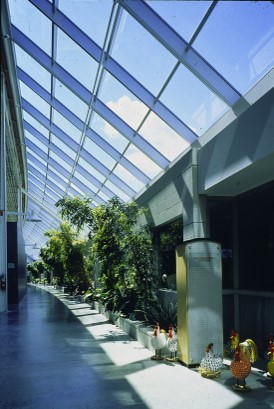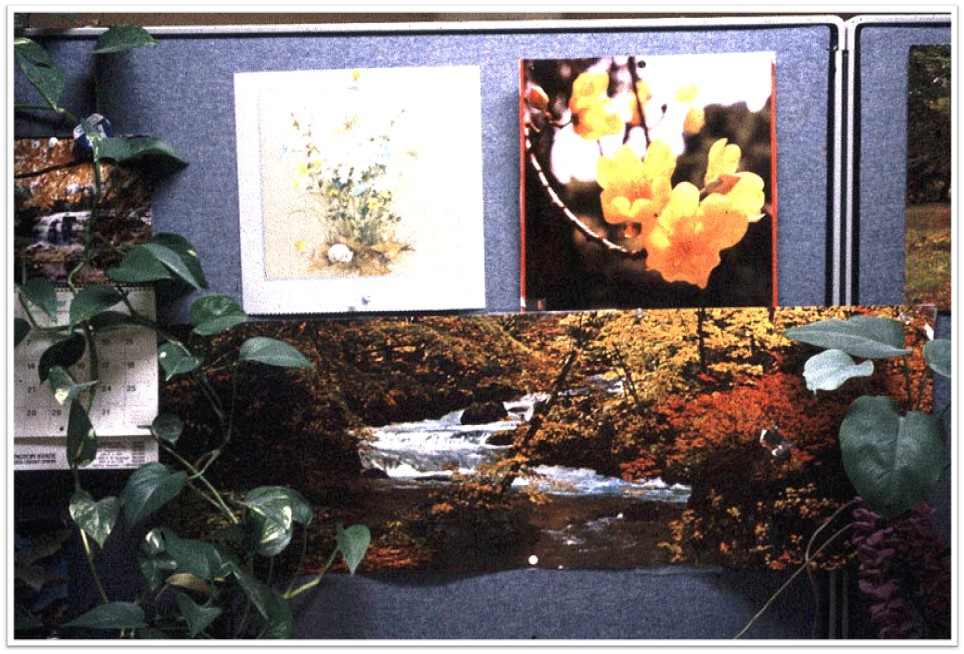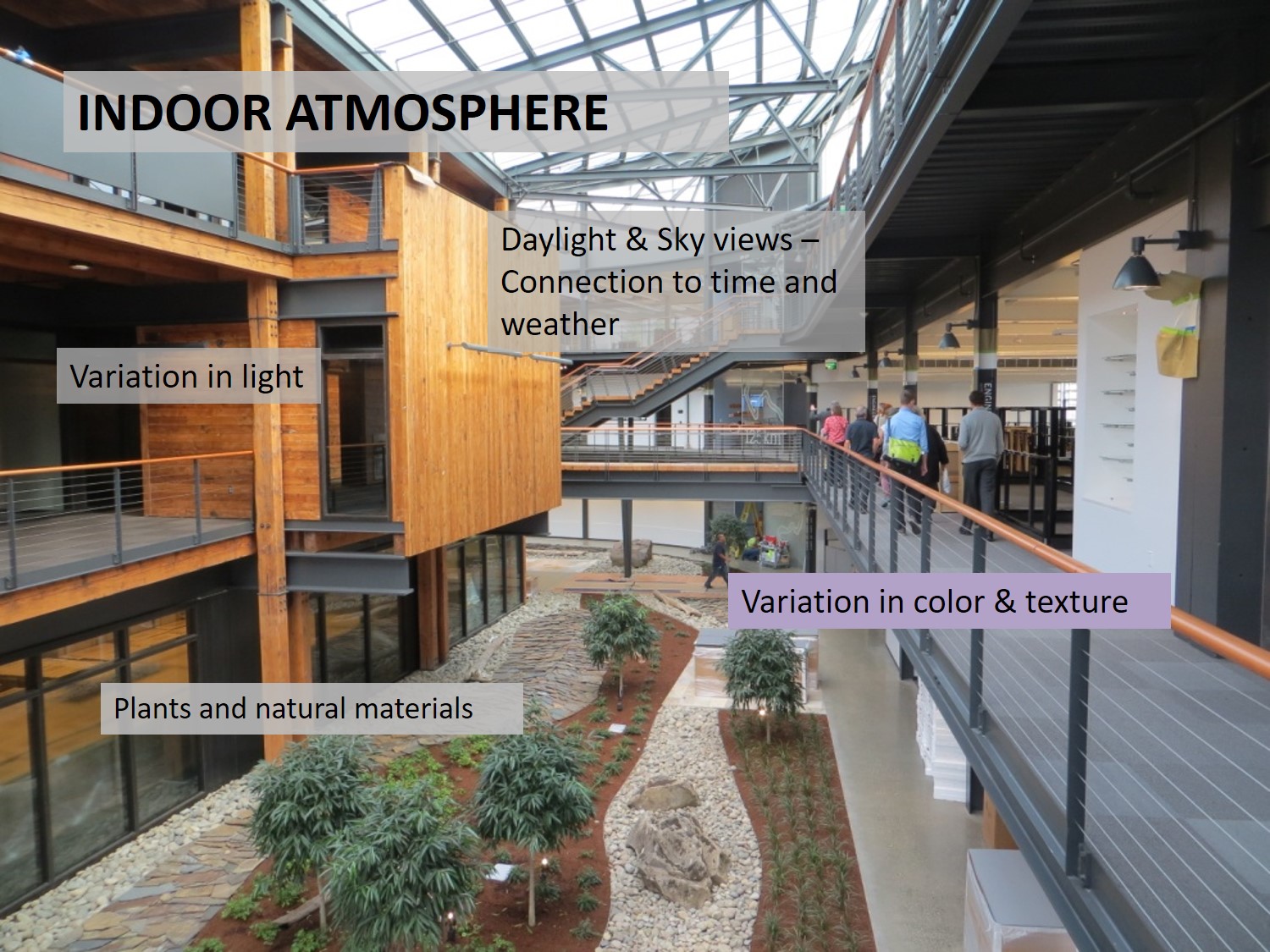Biophilic Design
Written by Judith Heerwagen, GSA's Office of Federal High-Performance Buildings
Case Study
The Importance of Daylight

While many people prefer to be in spaces with abundant daylight, a critical question is to what extent the benefits of daylight matter to those who spend the majority of their time indoors, particularly in an office setting.
Despite the fact that humans have lived primarily in built environments for thousands of years, there still lives within the human psyche an evolved propensity to affiliate with living organisms and natural systems. We still feel the tug of nature in backyard gardens, street trees, bird feeders, flowers, or the changing patterns of light indoors as the sun makes its pathway across the sky. An extensive body of research shows that our desire to affiliate with nature also is good for us. The following sections address why nature is so important to us, what we know about the benefits of nature, and how biophilia is being applied in buildings, particularly in urban settings. It is not intended to be an extensive review of the research literature, but rather to highlight how biophilia can be integrated into the built environment, hand in hand with sustainability, to enhance human health, performance and well-being.
Why is nature important to us?
In his influential 1984 book, Biophilia, E.O.Wilson defines biophilia as “the tendency to focus on life and life-like processes.” Wilson argues that because the brain evolved in a biocentric world, humans should be especially tuned to features and attributes of nature that have had consequences for survival – either in a positive or negative way. For biophilic design, it is important to understand how to draw on the survival and well being benefits of nature to enhance human experience of place and to reduce or eliminate environmental features that create health or survival risks.
How Do We Know Biophilia Enhances Health?
Interest in biophilia within both the research and design communities has grown rapidly since E.O. Wilson’s 1984 book on biophilia. A 2018 Google search on the term “biophilia” provided 1,760,000 hits while “biophilic design” produced 619,000 hits. Not surprisingly, research on the topic has also grown considerably, especially on the human benefits of connection to nature, and more recently, on issues of how urban biophilia can help mitigate climate change while also supporting public health goals.
This section provides an overview of key findings on the links between human health resulting from a variety of biophilic applications – from indoor vegetation and daylight to window views and water features. The focus is primarily on biophilia in the built environment.
Due to the extensive body of research on biophilia, this section is intended to identify key findings relevant to building design rather than to provide a detailed review. Recent reviews are identified in the bibliography for those wanting more information.
Table 1. Links Between Biophilic Elements and Health Outcomes
| Design Element | Stress Reduction | Enhanced Mood | Improved Cognitive Performance | Enhanced Social Engagement | Enhanced Sleep | Enhanced Movement |
| Indoor Plants | X | X | X | |||
| Fish tanks | X | X | ||||
| Flowers | X | |||||
| Water | X | X | ||||
| Views and images of nature | X | X | ||||
| Daylight & circadian effective light | X | X | X | |||
| Thermal transitions | X | |||||
| Outdoor green space | X | X | X | |||
| Varied spatial environment | X | X | ||||
| Green roofs | X | X | ||||
| Natural, fractal patterns | X |
Daylight Matters
In addition to creating a visually pleasant environment, indoor daylight can also enhance mood, improve cognitive functioning, reduce stress, and reduce the use of strong pain medicine in hospital settings.
Window Views of Nature Make a Difference
While much research on windows has focused on reduction of glare and heat gain, the health benefits of views is an active area of research. Results show that views of trees and vegetation reduce stress, enhance mood, improve the recovery process in hospitals, and enhance cognitive performance in work settings compared to views lacking natural features.
Indoor Plants and Flowers Are More than Decorations
Plants have long been used to enhance the appearance of indoor spaces. Research on the benefits of plants also shows reduced respiratory symptoms likely linked to improved air quality. In addition to green plants, flowers are also associated with positive outcomes, especially increases in positive emotional functioning.
Nature Photos and Videos Can Be Effective Surrogates
Health benefits can also be achieved indirectly through the use of photos or videos of nature. Research shows both physiological and psychological responses to nature versus urban scenes. The findings show strong support for more positive benefits with nature-based visual stimuli.
Adaptations to Windowless Environments Using Nature Decor
Although people have a strong preference for working in spaces that have windows, there are many windowless work environments. Research shows that people in such spaces often decorate their workspaces with nature posters or plants, perhaps as a way to compensate for lack of connection to the outdoors.
The Psychological Value of Water
Given its importance to human life, studies on the health benefits of water are surprisingly scarce compared to the extensive research on water-borne health problems. However, researchers have begun to focus on the qualities of water that influence people’s preferences. A review of human responses to a variety of water features (referred to as “blue space”) concludes that water is clearly a component of preferred landscapes.15
Prospect and Refuge
Landscape design intuitively uses prospect (long distance views) and refuge (places of protection), with multiple long distant views often to the horizon, coupled with subspaces that offer protection and hiding.
The co-occurrence of prospect seems to be so obvious that research on the topic is scarce. However, one compelling study of human response to landscape scenes shows that those with both long distance views and places of refuge stimulate the opioid centers of the brain, creating a sense of relaxed enjoyment that may encourage movement and exploration.18
Non-Visual Sensory Systems
Environmental experience is multi sensory, not just visual. Yet less attention has been paid to other sensory systems in biophilia research. However, research in other fields such as acoustics and thermal comfort address conditions relevant to biophilia.
For example, recent work on sound looks at the health impact of soft nature sounds (birds, water, breezes) versus annoying sounds such as traffic, construction work, and people talking on cell phones.19 The authors conclude that quiet sounds linked to nature are indicative of safety and thus reduce stress and restore attentional capabilities allowing for high level cognitive functioning, including creativity. Louder, annoying sounds are more indicative of danger, and thus narrow attentional scope to focus on dealing with the danger.
Other researchers are exploring how thermal transitions can create momentary pleasure and result in greater satisfaction overall than constant indoor temperature conditions.20 Whether such transitions could also create a sense of pleasure for other sensory stems is not known. However, the high variability in natural light across the day suggests that more indoor variability – especially in windowless environments – could generate feelings of pleasure also.
Overall summary of Research Findings
Research on biophilia shows that many different elements of nature, from daylight to plants and flowers, have consistent positive benefits on human health and well point to positive outcomes linked to attention restoration and stress reduction – both of which can enable more focus and greater use of executive functions associated with more complex cognitive performance.
Key conclusions from this research, as summarized in a review by Beute and de Kort are:21
- Biophilic benefits have validated pathways of impact - including psychological mechanisms (preference, psychological stress reduction, emotional functioning, cognitive processes, and to a lesser extent social behavior) and physiological mechanisms (circadian entrainment, serotonin production, alertness, and physiological stress reduction).
- The aspects of nature associated with these outcomes are consistent across diverse research projects and include large trees, plants, distant views, refuge, sunlight, and water.
Implementing Biophilic Design
Biophilic design translates our evolved propensity to affiliate with nature into strategies for improving health, well-being, and performance in the built environment. The brief review above shows that biophilic features have numerous positive benefits including stress reduction, enhanced emotional functioning, improved cognitive performance, social engagement, and better sleep.
In addition to elements and spaces that enhance experience of place, it’s important to also avoid spaces associated with danger or illness – a condition often referred to as “biophobia” because of the unease and stress associated with being in a space that can harm rather than heal. Like biophilia, the sense of biophobia is considered an evolved response intended to elicit avoidance or escape behaviors.
Features associated with biophobia include:
- Darkness
- Loud or uncontrollable noise
- Unkempt or hazardous spaces
- Presence of vermin and/or unpleasant odors
- Dead or dying plants due to lack of care
- Poor wayfinding leading to feeling trapped or lost
The Biophilic Design Continuum
One way to think about biophilic design is to see it as a continuum as shown below. As one moves from a biophobic to a biophilic space, there is an in-between space (bio-indifference) that eliminates the negative aspects of biophobia, but does not contain the natural features and attributes that promote health. Many current building spaces are likely to fall in the “bio-indifference” category where harmful elements are largely eliminated, but health-enhancing benefits are not present. An infographic from the Washington Post![]() illustrates the concept.
illustrates the concept.
Table 2. The Biophilic Design Continuum
| Biophobia | Bio-Indifference | Biophilia | |||
| Factors associated with the biophilic design continuum |
|
|
|
||
| Health & well-being consequences |
|
|
|
||
 |
 |
 |
|||
|
Dark hallways
|
High Partitions
|
Hallway with lights and plants
|
Table 3 below summarizes the components of biophilic design in terms of specific elements, natural attributes, and spatial patterns. This is just one way to characterize biophilia. Others categorization schemes and practice approaches are presented in the 14 Patterns of Biophilic Design by Terrapin Bright Green19 and in The Practice of Biophilic Design by Stephen Kellert and Elizabeth Calabrese.20
Table 3. Components of Biophilic Design
| Component | Examples |
|---|---|
| Natural Elements | |
| Living nature | Trees, flowers, water and animals in the form of green walls, potted plants, and fish tanks or koi ponds. |
| Connection to nature can be through nearby outdoor spaces, window views or indoor applications. | |
| Natural materials | Wood and stone increase the appeal of a space and provide visual and haptic variability. |
| Life-like elements | Life-like elements include light, sky, fire and water. The term “life like” refers to the capacity for these elements to change over time and to be present in different forms. |
| Natural Attributes | |
| Sensory variability | Sensory variability includes variation in sounds, light, color, temperature and air movement across spaces and time. |
| Patterned complexity | Patterned complexity (“rhyming”) includes elements that vary, yet have an organizing theme (such as a flower garden). |
| Fractal patterns | Fractal patterns are common in nature (trees, rivers, wood) and can be used as décor in a variety of ways (carpet, wall hangings, paintings). |
| Spatial Relationships | |
| Prospect | Prospect can be achieved in many ways including internal and external views and view corridors; variation in view types and content (e.g., views of human activity or nature spaces), daylight, atria, wall wash lighting, viewing platforms (decks, terraces, balconies), use of mirrors to give the illusion of spaciousness. |
| Refuge | Refuge is illustrated by enclosure and sensory retreat using overhead canopies and vertical screening; balconies that provide both views and ability to stay in a darker area. |
| Enticement | Enticement such as curvilinear surfaces gradually open information to view and provide motivation to move and explore. |
Using the Biophilic Design Elements
The most biophilic buildings incorporate multiple features that are revealed in the building façade, lobby, interior design, and surrounding landscape. The intent is to create an interior habitat of features that go together in a harmonious way drawing on the features and attributes of the climate and landscape where the building is located.
A biophilic design does not need to contain all of the desired elements and attributes, but rather the components that make the most sense given the context – which, in addition to climate and landscape, include the building purpose (office vs hospital), the organizational culture and mission, and occupant needs and characteristics.
Federal Center South, Seattle
The new Federal Center South building in Seattle exemplifies an approach to biophilic design that links sustainability, organizational mission, and connection to nature indoors and outside. The building houses the US Army Corps of Engineers (USACE).
Biophilia was used as a framework for the overall design. The design includes expansive views across the building and to the outdoor landscape in all directions, an interior atrium with a meandering riverbed of rocks and plants, views to the Duamish River, extensive indoor daylight, and use of recycled wood for the interior walls. The building also has a well developed and balanced approach to prospect and refuge that includes open interior views coupled with numerous places for refuge without feeling totally enclosed.
Federal Center South received a LEED Platinum rating for its sustainable design and received the American Institute of Architects COTE award and COTE+ award for its stewardship of the environment.
Concluding Remarks
The research on biophilic benefits cited in this article come almost exclusively from adult populations. It is worth stepping back a bit and asking what would children say? The two images below come from children who were visiting a Herman Miller manufacturing plant in Holland, Michigan. Before the visit to the building, the teacher asked them to draw a picture of a factory. The photo on the left was typical of the drawings – they looked grim and dark. Hardly an exciting place to work. After the tour, when the children returned to class , the teacher asked them to draw another picture. The one shown here has happy people and the interior street lined with plants and wooden animals, including a snake and giraffe. Clearly, the experience had a powerful, positive emotional effect.
 |
 |
|
|
Children's factory drawing
|
Children's factory drawing after visit to Herman Miller Building
|
Additional Suggested Readings
- Appleton, J. 1977. The Experience of Landscape. London and New York: Wiley.
- Browning, W, Ryan, C. and Clancy, J. 2014. 14 Patterns of Biophilic Design
 . Terrapin Bright Green LLC.
. Terrapin Bright Green LLC. - Gillis, K. and Gatersleben, B. 2015. A review of psychological literature on the health and well being benefits of biophilic design. Buildings, 5: 948-963.
- International Living Future Institute

- Kellert, SR. 2018. Nature by Design: The Practice of Biophilic Design. New Haven: Yale University Press.
- Kellert, SR and Calabresse, EF. 2015. The Practice of Biophilic Design
 . Biophilic-design.com
. Biophilic-design.com - Kellert, SR, Heerwagen, J and Mador, M. 2008. Biophilic Design: The Theory, Science and Practice of Bringing Buildings to Life. New York: Wiley.
- Sturgeon, A. 2018. Creating Biophilic Buildings. Ecotone Publishing.
- Wilson, E.O. 1984. Biophilia. Cambridge, MA: Harvard University Press.
1 Orians, GH. 1980. Habitat selection: general theory and applications to human behavior. In J.S. Lockard (Ed) The Evolution of Human Social Behavior. Chicago: Elsevier 2 Appleton, J. 1975. The Experience of Landscape. New York: Wiley. 3 Walch, J.M., B.S. Rabin, R. Day, J. Williams, K. Choi, J.D. Kang, 2005. The effect of sunlight in postoperative analgesic medication use: a prospective study of patients undergoing spinal surgery. Psychosomatic Medicine, 67(1): 156-163. 4 Figueiro, M., B. Steverson, J. Heerwagen, K.Kampschroer, C.M. Hunter, K. Gonzales, B. Plitnick, and M.S. Rea, 2017. The impact of daytime light exposures on sleep and mood in office workers. Sleep Health, 3: 204-215. 5 Urlich, R.S., 1984. View through a window may influence recovery from surgery. Science, 224:420-421. 6 Heschong, L., D. Aumann, N.Jenkins, T.Suries and R.L. Therkelsen, 2003. Windows and offices: a study of worker performance and the indoor environment. California Energy Commission, 1-5. 7 Kaplan R. 1983. The role of nature in the urban context. In .Altman and J.F. Wohlwill (Eds) Behavior and the Natural Environment. New York: Plenum. 8 Fjeld, T., B. Veiersted, L. Sandvik, G. Rilse, and F Levy, 1998. The effects of indoor foliage plants on health and discomfort symptoms among office workers. Indoor Built Environment. 7:204-209. 9 Haviland-Jones, J., H.H., Rosario, F, Wilson, P. and T. McGuire, 2005/ An environmental approach to positive emotion: flowers. Environmental Psychology, 3:104-132. 10 Orians, G.H. and Heerwagen, J.H. 1992. In J.H. Barkow, L. Cosmides, and J.Tooby (Eds). The Adapted Mind: Evolutionary Psychology and the Generation of Culture. New York and Oxford, University of Oxford Press. 11 Ulrich, R.S. 1993. Biophilia, Biophobia and Natural Landscapes. In S.R. Kellert and E.O.Wilson, Eds. The Biophilia Hypothesis. Washington DC: Island Press, Shearwater Books. 12 Ulrich, R.S., 1990. Effects of nature and abstract pictures on recovery from open heart surgery, Congress of Behavioral Medicine, Uppsala, Sweden. 13 Heerwagen, J.H. and Orians, G.H, 1986. Adaptations to windowlessness: A study of the use of visual décor in windowed and windowless offices. Environment and Behavior,18(5): 623-629. 14 Bringslimark, T, Hartig, T. and Patil, G.2011. Adaptation to windowlessness: do office workers compensate for a lack of visual access to the outdoors? Environment and Behavior 43(4): 469-487. 15 Volker, J. and Kistemann, T., 2011. The human impact of blue space on human health and well being: the salutogenic health effects of inland surface waters: a review. Journal of Hygiene and Environmental Health, 214 (6): 449-460. 16 Mador, M. 2008. Water, Biophilic Design and the Built Environment. In S.R.Kellert, J.H. Heerwagen, and M. Mador (Eds.) Biophilic Design: The Theory, Science and Practice of Bringing Buildings to Life. New York: Wiley. 17 Coss, R.G and Moore, M.1990. All that glistens: water connotations in surface finishes. Ecological Psychology, 2(4): 367-380. 18 Biederman,I and Vessel, E.A. 2006. Perceptual Pleasure and the Brain. American Scientist,248-255. 19 Alvaarsson, J.J., Wiens, S., and Nilsson, M.E., 2010. Stress recovery during exposures to nature sound and environmental noise. International Journal of Research in Public Health, 7:1036-1046. 20 Parkinson, T., deDear, R, and Candido, C. 2012. Perception of transient thermal environments: pleasure and alliesthesia, Proceedings of the 7th Windsor Conference, The Changing Context of Comfort in an Unpredictable World. Windsor, UK, April 12-15, 2012. 21 Beute, F. and deKort, Y.A. , 2014. Salutogenic effects of the environment: A review of health protective effects of nature and daylight. Applied Psychological: Health and Well Being, 6(1):67-90.
Related Topics
Biophilia
Biophilia addresses the human attraction to and desire to be in environments that have natural features including parks, gardens, street trees, bird feeders, flowers, big sky, and water elements. Decades of research show that affiliation with nature, whether outside or indoors, can enhance our physical, social and emotional health and boost performance.
Read more about Biophilic Design.
Biophilic Design
Biophilia addresses the human attraction to and desire to be in environments that have natural features including parks, gardens, street trees, bird feeders, flowers, big sky, and water elements. Decades of research show that affiliation with nature, whether outside or indoors, can enhance our physical, social and emotional health and boost performance.
Read more about Biophilic Design.
Healthy Buildings
Health, as defined by World Health Organization in its 1948 constitution, is “a state of complete physical, mental, and social well-being and not merely the absence of disease or infirmity”. This definition of health has been expanded in recent years to include (1) resilience and the ability to cope with health problems and (2) the capacity to return to an equilibrium state after health challenges.
These three health domains - physical, psychological, and social - are not mutually exclusive but rather interact to create a sense of health that changes over time and place. The challenge for building design and operations is to identify cost-effective ways to eliminate health risks while also providing positive physical, psychological, and social supports as well as coping resources.
Learn more about Buildings and Health.












